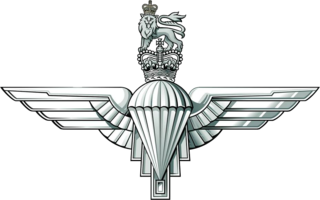This is the Operation Telic order of battle, which lists the British forces that took part in Operation Telic, including
This is a list of British ground forces in the Falklands War. For a list of ground forces from Argentina, see Argentine ground forces in the Falklands War

16 Air Assault Brigade is a formation of the British Army based in Colchester in the county of Essex. It is the Army's rapid response airborne formation and is the only brigade in the British Army focused on delivering air assault operations.

The Royal Horse Artillery (RHA) was formed in 1793 as a distinct arm of the Royal Regiment of Artillery of the British Army. Horses are still in service for ceremonial purposes but were phased out from operational deployment during the 1930s.
This is the complete order of battle of Allied and German forces involved during Operation Market Garden.

The 1st Cavalry Division was a regular Division of the British Army during the First World War where it fought on the Western Front. During the Second World War it was a first line formation, formed from Yeomanry Regiments. It fought in the Middle East before being converted to the 10th Armoured Division.

The 5th Infantry Brigade was a regular infantry brigade of the British Army that was in existence since before the First World War, except for a short break in the late 1970s, until amalgamating with 24th Airmobile Brigade, in 1999, to form 16 Air Assault Brigade.

562 Parachute Squadron Royal Corps of Transport (Volunteers) was a minor unit that supported 44th Parachute Brigade (V).
This is the Operation Herrick ground order of battle, which lists any British ground forces that have taken part in the duration of Operation Herrick between 2002 and 2014.

131 Commando Squadron Royal Engineers is an Army Reserve unit, and part of 24 Commando Regiment Royal Engineers. It provides engineering support to 3 Commando Brigade Royal Marines and is the largest Army Reserve Commando unit. The squadron has deployed worldwide to provide combat engineer support to 3 Cdo Bde RM, often deploying in small sub-units. 131 was first raised in 1947 as an airborne engineer regiment, and reached a strength of over 1,000 trained parachute engineers by the early 1960s. Between 1 April 1978 and 1 October 2015, the unit was an independent Commando squadron under operational command of HQ 3 Cdo Bde RM. On 2 October 2015, it formally became the third squadron of 24 Commando Engineer Regiment.
This is the order of battle of Allied and German forces during Operation Dragoon in August 1944 in the South of France.
Land Command was a military command and part of the structure of the modern British Army 1995-2008. Its headquarters was located at Erskine Barracks, at Fugglestone St Peter some four kilometres North West of Salisbury in Wiltshire.
This is the structure of the British Army in 1989.
The structure of the British Army before the reforms from Army 2020.

Headquarters North West formally known as 42nd Infantry Brigade and Headquarters North West is a regional command based in North West England. The command administers the reserve units based in its area and also provides the military support HQ for the police and civilian population in the area. In 2017, 42 Infantry Brigade was reduced to Headquarters North West.
The Options for Change were perhaps the most influential and largest cuts for the British Armed Forces only to be follow4r by Army 2020 as the other major reform. The Options for Change cut the army of almost 1/6 of its size and dramatically reduced the size of the British Army in Germany. Following this reform, the army was more focused to support the Allied Rapid Reaction Corps and defensive operations rather then an attacking role in Germany. This was made more evident when the 3rd Mechanised Division was withdrawn from Germany and based in England, and assigned directly to the Allied Rapid Reaction Corps.












